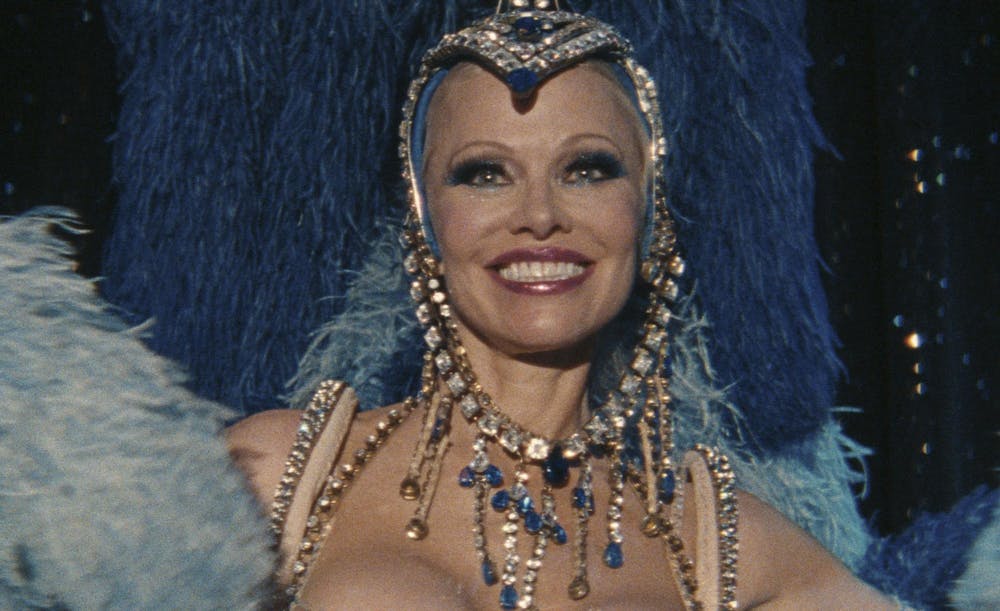Gia Coppola’s “The Last Showgirl” takes place in Las Vegas, but there’s not a single thing glamorous about it. There are none of the usual establishing shots of neon lights or jackpot winnings at the casino or dancing girls kicking their legs to Elvis Presley and Frank Sinatra’s greatest hits. It’s a Las Vegas of highways, parking lots, rental homes, gambling addicts and broken doorknobs. I was reminded often of Sean Baker’s 2017 film “The Florida Project,” which similarly follows a group of people, left behind by the American Dream, almost literally on the outskirts of capitalist society — in that film’s case, a cheap motel just outside of Walt Disney World.
There’s a moment toward the beginning of the film, when Jodie (Kiernan Shipka), a showgirl at Le Razzle Dazzle, makes an offhand remark to Annette (Jamie Lee Curtis), a former showgirl and current cocktail waitress at a casino, about retiring. Annette laughs, making it unambiguously clear she’s never going to retire. “What, do you think I have a 501(k)?” she says. It’s a hauntingly realistic look at working-class life in America: in 2024, the American Association of Retired People published a survey which showed that about a quarter of Americans over 50 have no retirement savings and expect that they’ll simply work for the rest of their lives.
Thus, what we have in this film is essentially a “character vs. society” conflict. Its three main characters — Annette, Shelly (Pamela Anderson) and Eddie (Dave Bautista) — are at once burdened by their circumstances but also trying to make the best of them. None of them are perfect people, their characters aren’t always likable, but, like all people, they’re simply engaging with their condition the best way they can. This deliberate choice to have Anderson star in the film then makes sense: director Gia Coppola chose her after seeing the 2023 Netflix documentary “Pamela, a Love Story,” which sought to recontextualize the model’s sensationalized life through her own narrative.
“After watching her documentary, you see she’s so full of art and creativity,” Coppola said in an interview with Interview Magazine. “She’s so knowledgeable about arthouse cinema and poetry. She’s a beautiful writer and a person that had a lot of vulnerability and similarities to Shelly.”
But, really, which of the main trio of actors made their fame in a way conventionally considered respectable to society at-large? Anderson cemented her status as a sex symbol by appearing in Playboy and starring in the television series “Baywatch.” Curtis is perhaps the most well-known scream queen of our era, noted for her appearances in often low-budget slasher and splatter flicks. Bautista joined the WWE in the early 2000s, helping sell out arenas with his professional wrestling. At the same time, none of these career paths are inherently reprehensible or wrong, any and all judgment is completely unwarranted and only perpetuates oppressive ideologies. And it’s here that we have the crux of the message of “The Last Showgirl.”
It’s an intensely intimate film, which is reflected, of course, in its performances, but also in its photography. Cinematographer Autumn Durald used a raw, gritty 16mm filmstock that’s often jittery and out-of-focus. But these choices are far from a flaw, Durald’s handheld camera capturing Shelly’s mental state as she struggles to move forward with the knowledge that Le Razzle Dazzle, where she’s performed for over three decades, is about to close. The movie’s aesthetic is appropriately off-kilter, forcing the viewer into an adjustment period that makes sense for its subject matter — Coppola, and necessarily Durald, are not needing you to understand the characters immediately, but instead asking you at least spend the time to get to know them before jumping to conclusions.
There are moments in this film that make it difficult for the audience to root for Shelly, but Anderson plays the character with such sensitivity and gracefulness that you can’t help but sympathize with her behavior and stay on her side come the end. Anderson, whose filmography includes films like “Scary Movie 3,” “Borat” and not much else, is a marvel here. Her performance has already received recognition from the Screen Actors Guild, and the buzz around a potential Oscar nomination has only been growing. Her performance is absolutely the film’s high point, and a high point from this past year — a nomination would be wholly deserved.
Unfortunately, the film falters with its script, being a bit too formulaic and reserved in exploring some of the crucial implications of the message Coppola desperately seems to try to convey. To pull the best examples from the film would be to spoil some of its major developments, but there are certain aspects of the plot that could’ve and should’ve been expanded on that would only have helped develop the film’s undeniable themes. At 89 minutes, “The Last Showgirl” was much too short — I compared it earlier to “The Florida Project,” which, at 111 minutes, takes the time to develop its characters more fully, provide the audience with some much- needed breathing room and, as such, doesn’t suffer from the same issues.
Nevertheless, despite its imperfect nature, “The Last Showgirl” is an incredibly earnest portrayal of the other side of Las Vegas and, thus, the other side of American culture. It’s a microcosmic look at people who would normally fall by the wayside, people who contribute to society by transgressing the line of what’s considered admirable. And, ultimately, it’s an experiment in empathy and compassion that succeeds in more ways than it fails.






